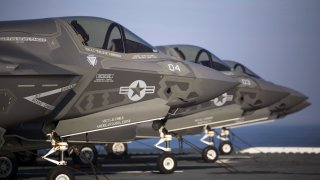America Can Now Fly F-35s off of Assault Ships—Here's Why That's a Big Deal
This marks the first time the jet has deployed operationally onboard a large deck amphibious assault ship.
The U.S. Marine Corps has deployed a detachment of Lockheed Martin F-35B Joint Strike Fighters onboard USS Wasp (LHD-1), marking the first time the jet has deployed operationally onboard a large deck amphibious assault ship.
The arrival of the F-35B onboard the L-class ships mark a massive boost in striking power for the roughly 40,000-ton vessels—effectively turning them into light carriers. Indeed, until the United States Navy’s F-35C version becomes operational, the F-35B will be the only stealth aircraft to be found onboard a naval flight deck.
"Pairing F-35B Lightning II's with the Wasp represents one of the most significant leaps in warfighting capability for the Navy-Marine Corps team in our lifetime," Rear Adm. Brad Cooper, commander, Expeditionary Strike Group 7, said. "This 5th generation stealth jet is extremely versatile and will greatly enhance and expand our operational capabilities."
Capt. Colby Howard, Wasp’s commanding officer, is understandably proud of his newly upgraded vessel and its embarked aircraft. Indeed, F-35B was tested at sea for the first time onboard Wasp when the jet was being developed.
"Deployment of the versatile F-35B enhances the full range of Expeditionary Strike Group capabilities with one of the world's most technologically-advanced air warfare platforms," Howard said. "With the specific upgrades Wasp has received, the Navy Marine Corps team in the Pacific is better positioned than ever before to support our commitment to the security of Japan and the Region."
The Wasp Expeditionary Strike Group (ESG) will be part of a new type of unit that offers far greater firepower than the three-ship amphibious warfare groups that have become commonplace in the post–Cold War era. Instead, the new 'Up-Gunned ESG' will not only incorporate the F-35B but also the Arleigh Burke–class guided-missile destroyers USS Dewey (DDG 105) and USS Sterett (DDG 104), which will enable the ESG to be more effective against peer-level threats such as Chinese or Russian forces.
“The 'Up-gunned ESG' is a U.S. Pacific-fleet initiated concept that aims to provide lethality and survivability to a traditional three-ship amphibious ready group by integrating multi-mission surface combatants and F-35B into amphibious operations,” the Navy’s 7th Fleet said in a statement. “By adding these enabling capabilities, the amphibious force can more effectively defend against adversarial threats in the undersea, surface and air domains, as well provide offensive firepower to strike from the sea.”
The F-35B should also be useful for the Marines’ operations ashore as a more capable support aircraft for the service’s infantry than the venerable Boeing AV-8B Harrier II jump jet. "This is a historic deployment," Col. Tye R. Wallace, 31st Marine Expeditionary Unit commanding officer, said. "The F-35B is the most capable aircraft ever to support a Marine rifleman on the ground. It brings a range of new capabilities to the MEU that make us a more lethal and effective Marine Air-Ground Task Force."
Dave Majumdar is the defense editor for The National Interest. You can follow him on Twitter: @davemajumdar.
Image: U.S. Marines

